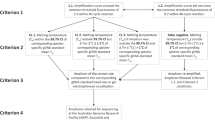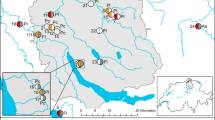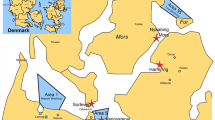Abstract
The global ornamental fish trade enables translocation of exotic aquatic pathogens. In many countries, health certification and visual inspection of imported fish are key components of biosecurity to prevent the introduction of aquatic diseases. However, infected fish do not always exhibit clinical or behavioural signs of disease, and alternatives to visual inspection must be validated. This study examined the use of environmental DNA (eDNA) to detect sub-clinical parasite infections at border control. We simulated the export process of live ornamental fish in which non-infected fish, infected fish, treated fish, and non-infected fish held in contaminated water were packaged and delivered in 48 h. Quantitative PCR (qPCR) was used to detect eDNA of an ectoparasitic monogenean, Neobenedenia girellae, infecting barramundi, Lates calcarifer. The qPCR assay did not reliably detect parasite eDNA under 2 copies/µL from fish with sub-clinical infections (mean parasite intensity = 6.80 ± 4.78 S.D.), suggesting parasite infection loads tested in this study may be too low for reliable detection within the timeframe used to export live ornamental fish. Quantitative PCR tests detected parasite eDNA in 50% of infected fish and 70% of non-infected fish in contaminated transport water. This indicated a high plausibility of false negative detections because of low eDNA concentrations in transport water and false positive detections of DNA from dead parasites in the water. Environmental DNA screening methods for border control biosecurity must overcome limitations posed by low eDNA concentrations in the water, limited timeframes for sample processing, and the essential differentiation between live parasite infections and dead, non-viable parasites.




Similar content being viewed by others
References
Agawa Y, Tani K, Yamamoto S, Hirano C, Shirakashi S (2016) Development of a quantitative polymerase chain reaction assay for the detection of skin fluke Neobenedenia girellae larvae from environmental water. Fish Sci 82:827–833
Balasingham KD, Walter RP, Heath DD (2017) Residual eDNA detection sensitivity assessed by quantitative real-time PCR in a river ecosystem. Mol Ecol Res 17:523–532. https://doi.org/10.1111/1755-0998.12598
Barnes MA, Turner CR (2016) The ecology of environmental DNA and implications for conservation genetics. Conserv Gen 17:1–17
Bass D, Stentiford GD, Littlewood DTJ, Hartikainen H (2015) Diverse applications of environmental DNA methods in parasitology. Trends Parasitol 31:499–513. https://doi.org/10.1016/j.pt.2015.06.013
Bastos-Gomes G, Hutson K, Domingos J, Chung C, Hayward S, Miller T, Jerry D (2017) Use of environmental DNA (eDNA) and water quality data to predict protozoan parasites outbreaks in fish farms. Aquaculture 479:467–473. https://doi.org/10.1016/j.aquaculture.2017.06.021
Becker JA, Tweedie A, Rimmer A, Landos M, Lintermans M, Whittington RJ (2014) Incursions of cyprinid herpesvirus 2 in goldfish populations in Australia despite quarantine practices. Aquaculture 432:53–59. https://doi.org/10.1016/j.aquaculture.2014.04.020
Brazenor AK, Hutson KS (2015) Effects of temperature and salinity on the life cycle of Neobenedenia sp. (Monogenea: Capsalidae) infecting farmed barramundi (Lates calcarifer). Parasitol Res 114:1875–1886. https://doi.org/10.1007/s00436-015-4375-5
Brazenor AK, Bertozzi T, Miller TL, Whittington ID, Hutson KS (2018) DNA profiling reveals Neobenedenia girellae as the primary parasitic monogenean in global fisheries and aquaculture. Mol Phylogen Evol 129:130–137. https://doi.org/10.1016/j.ympev.2018.05.012
Bylemans J, Furlan EM, Gleeson DM, Hardy CM, Duncan RP (2018) Does size matter? An experimental evaluation of the relative abundance and decay rates of aquatic environmental DNA. Environ Sci Technol 52:6408–6416. https://doi.org/10.1021/acs.est.8b01071
Cai XQ, Xu MJ, Wang YH, Qiu DY, Liu GX, Lin A, Tang JD, Zhang RL, Zhu XQ (2010) Sensitive and rapid detection of Clonorchis sinensis infection in fish by loop-mediated isothermal amplification (LAMP). Parasitol Res 106:1379–1383. https://doi.org/10.1007/s00436-010-1812-3
Collins RA, Armstrong KF, Holyoake AJ, Keeling S (2013) Something in the water: biosecurity monitoring of ornamental fish imports using environmental DNA. Biol Invasions 15:1209–1215. https://doi.org/10.1007/s10530-012-0376-9
Corinaldesi C, Beolchini F, Dell’Anno A (2008) Damage and degradation rates of extracellular DNA in marine sediments: implications for the preservation of gene sequences. Mol Ecol 17:3939–3951. https://doi.org/10.1111/j.1365-294X.2008.03880.x
Darling JA, Mahon AR (2011) From molecules to management: adopting DNA-based methods for monitoring biological invasions in aquatic environments. Environ Res 111:978–988. https://doi.org/10.1016/j.envres.2011.02.001
Della-Venezia L, Samson J, Leung B, Thuiller W (2018) The rich get richer: Invasion risk across North America from the aquarium pathway under climate change. Divers Distrib 24:285–296. https://doi.org/10.1111/ddi.12681
Doherty TS, Glen AS, Nimmo DG, Ritchie EG, Dickman CR (2016) Invasive predators and global biodiversity loss. Proc Nat Acad Sci 113:11261–11265. https://doi.org/10.1073/pnas.1602480113
Duggan IC (2010) The freshwater aquarium trade as a vector for incidental invertebrate fauna. Biol Invasions 12:3757–3770. https://doi.org/10.1007/s10530-010-9768-x
Foran DR (2006) Relative degradation of nuclear and mitochondrial DNA: an experimental approach. J Foren Sci 51:766–770. https://doi.org/10.1111/j.1556-4029.2006.00176.x
Gaither MR, Aeby G, Vignon M, Meguro Y, Rigby M, Runyon C, Toonen RJ, Wood CL, Bowen BW (2013) An invasive fish and the time-lagged spread of its parasite across the Hawaiian archipelago. PLoS ONE 8:e56940. https://doi.org/10.1371/journal.pone.0056940
Goldberg CS, Turner CR, Deiner K, Klymus KE, Thomsen PF, Murphy MA, Spear SF, McKee A, Oyler-McCance SJ, Cornman RS, Laramie MB, Mahon AR, Lance RF, Pilliod DS, Strickler KM, Waits LP, Fremier AK, Takahara T, Herder JE, Taberlet P, Gilbert M (2016) Critical considerations for the application of environmental DNA methods to detect aquatic species. Methods Ecol Evol 7:1299–1307. https://doi.org/10.1111/2041-210X.12595
Goven BA, Amen DF (1982) Mebendazole/trichlorfon combination: a new anthelmintic for removing monogenetic trematodes from fish. J Fish Biol 20:373–378. https://doi.org/10.1111/j.1095-8649.1982.tb03931.x
Hallett SL, Ray RA, Hurst CN, Holt RA, Buckles GR, Atkinson SD, Bartholomew JL (2012) Density of the waterborne parasite Ceratomyxa shasta and its biological effects on salmon. Appl Environ Microbiol 78:3724–3731. https://doi.org/10.1128/AEM.07801-11
Hick P, Evans O, Looi R, English C, Whittington RJ (2016) Stability of ostreid herpesvirus-1 (OsHV-1) and assessment of disinfection of seawater and oyster tissues using a bioassay. Aquaculture 450:412–421. https://doi.org/10.1016/j.aquaculture.2015.08.025
Hinlo R, Gleeson D, Lintermans M, Furlan E, Doi H (2017) Methods to maximise recovery of environmental DNA from water samples. PLOS ONE 12(6):e0179251
Hutson KS, Brazenor AK, Vaughan DB, Trujillo-González A (2018) Monogenean parasite cultures: current techniques and recent advances. Adv Parasitol 99:61–91. https://doi.org/10.1016/bs.apar.2018.01.002
Huver JR, Koprivnikar J, Johnson PTJ, Whyard S (2015) Development and application of an eDNA method to detect and quantify a pathogenic parasite in aquatic ecosystems. Ecol Appl 25:991–1002. https://doi.org/10.1890/14-1530.1
Kaneko JJ II, Yamada R, Brock JA, Nakamura RM (1988) Infection of tilapia, Oreochromis mossambicus (Trewavas), by a marine monogenean, Neobenedenia melleni (MacCallum, 1927) Yamaguti, 1963 in Kaneohe Bay, Hawaii, USA, and its treatment. J Fish Dis 11:295–300. https://doi.org/10.1111/j.1365-2761.1988.tb01225.x
Lahoz-Monfort JJ, Guillera-Arroita G, Tingley R (2016) Statistical approaches to account for false-positive errors in environmental DNA samples. Mol Ecol Res 16:673–685. https://doi.org/10.1111/1755-0998.12486
Lee PLM (2017) DNA amplification in the field: move over PCR, here comes LAMP. Mol Ecol Res 17:138–141. https://doi.org/10.1111/1755-0998.12548
Lockwood JL, Hoopes MF, Marchetti MP (2013) Ecological impacts of invasive species. In: Lockwood JL, Hoopes MF, Marchetti MP (eds) Invasion ecology, 2nd edn. Wiley-Blackwell, West Sussex, pp 298–333
Lymbery AJ, Morine M, Kanani HG, Beatty SJ, Morgan DL (2014) Co-invaders: the effects of alien parasites on native hosts. Int J Parasitol Par Wild 3:171–177. https://doi.org/10.1016/j.ijppaw.2014.04.002
Pietramellara G, Ascher J, Borgogni F, Ceccherini MT, Guerri G, Nannipieri P (2009) Extracellular DNA in soil and sediment: fate and ecological relevance. Biol Fert Soils 45:219–235. https://doi.org/10.1007/s00374-008-0345-8
Pochon X, Zaiko A, Fletcher L, Laroche O, Wood S (2017) Wanted dead or alive? Using metabarcoding of environmental DNA and RNA to distinguish living assemblages for biosecurity applications. PLoS ONE 12:e0187636. https://doi.org/10.1371/journal.pone.0187636
Poulsen LK, Ballard G, Stahl DA (1993) Use of rRNA fluorescence in situ hybridization for measuring the activity of single cells in young and established biofilms. Appl Environ Microbiol 59:1354–1360
Rimmer AE, Becker JA, Tweedie A, Lintermans M, Landos M, Stephens FJ, Whittington RJ (2015) Prevalence and distribution of dwarf gourami iridovirus (Infectious spleen and kidney necrosis virus) in populations of ornamental fish prior to and after importation into Australia, with the first evidence of infection in domestically farmed Platy (Xiphophorus maculatus). Prev Vet Med 122:181–194. https://doi.org/10.1016/j.prevetmed.2015.09.008
Ririe KM, Rasmussen RP, Wittwer CT (1997) Product differentiation by analysis of DNA melting curves during the polymerase chain reaction. Anal Biochem 245:154–160. https://doi.org/10.1006/abio.1996.9916
Robson H, Noble T, Saunders R, Robson S, Burrows D, Jerry D (2016) Fine-tuning for the tropics: application of eDNA technology for invasive fish detection in tropical freshwater ecosystems. Mol Ecol Res 16:922–932. https://doi.org/10.1111/1755-0998.12505
Ruijter JM, Ramakers C, Hoogaars WMH, Karlen Y, Bakker O, van den Hoff MJB, Moorman AFM (2009) Amplification efficiency: linking baseline and bias in the analysis of quantitative PCR data. Nucleic Acids Res 37(6):e45
Rusch JC, Hansen H, Strand DA, Markussen T, Hytterød S, Vrålstad T (2018) Catching the fish with the worm: a case study on eDNA detection of the monogenean parasite Gyrodactylus salaris and two of its hosts, Atlantic salmon (Salmo salar) and rainbow trout (Oncorhynchus mykiss). Para Vect 11:1–12. https://doi.org/10.1186/s13071-018-2916-3
Sala OE, Chapin FS, Armesto JJ, Berlow E, Bloomfield J, Dirzo R, Huber-Sanwald E, Huenneke LF, Jackson RB, Kinzig A, Leemans R, Lodge DM, Mooney HA, Oesterheld M, Poff NL, Sykes MT, Walker BH, Walker M, Wall DH (2000) Biodiversity—global biodiversity scenarios for the year 2100. Science 287:1770–1774
Sandilyan S (2016) Occurrence of ornamental fishes: a looming danger for inland fish diversity of India. Curr Sci 110:2099–2104. https://doi.org/10.18520/cs/v110/i11/2099-2104
Schelkle B, Doetjes R, Cable J (2011) The salt myth revealed: treatment of gyrodactylid infections on ornamental guppies, Poecilia reticulata. Aquaculture 311:74–79. https://doi.org/10.1016/j.aquaculture.2010.11.036
Schmidt BR, Kéry M, Ursenbacher S, Hyman OJ, Collins JP (2013) Site occupancy models in the analysis of environmental DNA presence/absence surveys: a case study of an emerging amphibian pathogen. Methods Ecol Evol 4:646–653. https://doi.org/10.1111/2041-210X.12052
Sergeant ESG (2018) Epitools epidemiological calculators. Ausvet Pty Ltd. http://epitools.ausvet.com.au. Accessed Feb 2018
Simpson TJS, Dias PJ, Snow M, Muñoz J, Berry T (2017) Real-time PCR detection of Didemnum perlucidum (monniot, 1983) and Didemnum vexillum (Kott, 2002) in an applied routine marine biosecurity context. Mol Ecol Res 17:443–453. https://doi.org/10.1111/1755-0998.12581
Soliman H, Saleh M, El-Matbouli M (2014) Detection of fish pathogens by loop-mediated isothermal amplification (LAMP) technique. Methods Mol Biol 1247:163–173. https://doi.org/10.1007/978-1-4939-2004-4_12
The Australian Government Department of Agriculture and Water Resources (DAWR) (2018) Biosecurity Import Conditions System (BICON). www.agriculture.gov.au/import/online-services/bicon. Accessed 10 Oct 2018
Thomsen P, Willerslev E (2015) Environmental DNA—an emerging tool in conservation for monitoring past and present biodiversity. Biol Conserv 183:4–18. https://doi.org/10.1016/j.biocon.2014.11.019
Thoney DA, Hargis WJ (1991) Monogenea (Platyhelminthes) as hazards for fish in confinement. Ann Rev Fish Dis 1:133–153. https://doi.org/10.1016/0959-8030(91)90027-H
Toldrà A, Andree KB, Fernández-Tejedor M, Diogène J, Campàs M (2018) Dual quantitative PCR assay for identification and enumeration of Karlodinium veneficum and Karlodinium armiger combined with a simple and rapid DNA extraction method. J Appl Phycol 30:1–11. https://doi.org/10.1007/s10811-018-1446-x
Trujillo-González A, Constantinoiu CC, Rowe R, Hutson KS (2015) Tracking transparent monogenean parasites on fish from infection to maturity. Int J Parasitol Para Wild 4:316–322. https://doi.org/10.1016/j.ijppaw.2015.06.002
Trujillo-González A, Becker JA, Vaughan DB, Hutson KS (2018) Monogenean parasites infect ornamental fish imported to Australia. Parasitol Res 117:995–1011. https://doi.org/10.1007/s00436-018-5776-z
Trujillo-González A, Edmunds RC, Becker JA, Hutson KS (2019) Parasite detection in the ornamental fish trade using environmental DNA. Sci Rep 9:5173–5179. https://doi.org/10.1038/s41598-019-41517-2
Whittington R, Chong R (2007) Global trade in ornamental fish from an Australian perspective: the case for revised import risk analysis and management strategies. Prev Vet Med 81:92–116. https://doi.org/10.1016/j.prevetmed.2007.04.007
Williams M, Stedtfeld R, Engle C, Salach P, Fakher U, Stedtfeld T, Dreelin E, Stevenson RJ, Latimore J, Hashsham SA (2017) Isothermal amplification of environmental DNA (eDNA) for direct field-based monitoring and laboratory confirmation of Dreissena sp. PLoS ONE 12:e0186462. https://doi.org/10.1371/journal.pone.0186462
Wood SA, Pochon X, Laroche O, von Ammon U, Adamson J, Zaiko A (2019) A comparison of droplet digital polymerase chain reaction (PCR), quantitative PCR and metabarcoding for species-specific detection in environmental DNA. Mol Ecol Res. https://doi.org/10.1111/1755-0998.13055
Zaiko A, Pochon X, Garcia-Vazquez E, Olenin S, Wood SA (2018) Advantages and limitations of environmental DNA/RNA tools for marine biosecurity: management and surveillance of non-indigenous species. Front Marine Sci. https://doi.org/10.3389/fmars.2018.00322
Zhou Y, Xiao J, Ma X, Wang Q, Zhang Y (2018) An effective established biosensor of bifunctional probes-labelled AuNPs combined with LAMP for detection of fish pathogen Streptococcus iniae. Appl Microbiol Biotechnol 102:1–10. https://doi.org/10.1007/s00253-018-9016-3
Acknowledgements
We thank David B. Vaughan, Katie Motson, Pauline Narvaez, Quyen Banh and Renato Morais-Araujo for their assistance in the laboratory. This study was funded by the Australian Government through the Fisheries Research and Development Corporation (FRDC) (Project No. 2014/001), the University of Sydney, and James Cook University.
Author information
Authors and Affiliations
Corresponding author
Ethics declarations
Conflict of interest
The author(s) declare no conflicts of interest.
Data accessibility
Data from this study can be accessed in the Tropical Research Hub of James Cook University, Australia, as follows: Trujillo Gonzalez, A. (2018). Can environmental DNA be used for aquatic biosecurity in the aquarium fish trade? James Cook University. https://doi.org/10.25903/5bd295b16d2ad [Data Files].
Additional information
Publisher's Note
Springer Nature remains neutral with regard to jurisdictional claims in published maps and institutional affiliations.
Electronic supplementary material
Below is the link to the electronic supplementary material.
Rights and permissions
About this article
Cite this article
Trujillo-González, A., Becker, J.A., Huerlimann, R. et al. Can environmental DNA be used for aquatic biosecurity in the aquarium fish trade?. Biol Invasions 22, 1011–1025 (2020). https://doi.org/10.1007/s10530-019-02152-0
Received:
Accepted:
Published:
Issue Date:
DOI: https://doi.org/10.1007/s10530-019-02152-0




